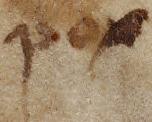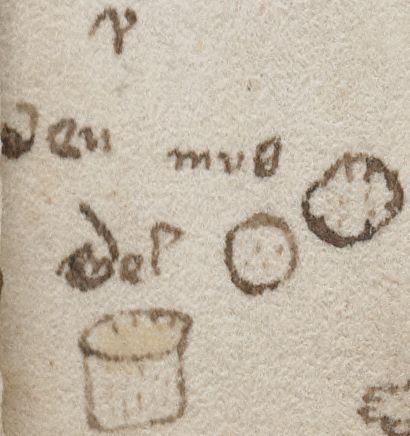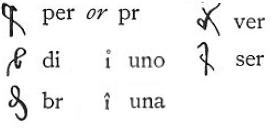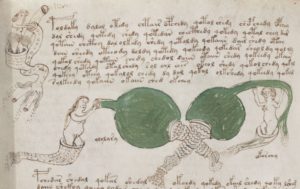“You do realize“, added the man with the tinfoil hat, nodding thoughtfully on the webcam, “that he’s completely mad. For all his qualifications, there really is no reasoning with him.”
“Dave, please rest assured that I fully take your point”, said the journalist, disconnecting as fast as she possibly could. She slumped back in her chair, increasingly desperate for a drink, any kind of short-term alcohol hit to prop up her dipping blood sugar level. Only two more days to the copy deadline for her 2000-word Voynich Manuscript Sunday supplement article, and all Katrina had for her efforts was a rapid succession of dull talking heads, each with basically nothing of substance to say about the manuscript itself, all the while bristling with shirty hatred for anyone who happened to disagree with their pet theory. And, as a general rule, the more entertaining the shirtiness, the less tenable the theory would be.
‘Star Trek Dave’ from Seattle certainly matched that template to a T: OK, so he didn’t actually say the Voynich was written in Middle High Klingon, but he was more than happy to demonstrate the extensive statistical similarities between the two, and positively ecstatic to be given the opportunity to trash anybody at all who thought it was some kind of hoax. He claimed that the shiny hat was to stop his head overheating in the sun: all the same, she couldn’t help but notice the overcast sky behind him in the webcam. What… a… mess.
Numbly, Katrina scanned through the rest of the list of Voynicheros she had planned to interview today: ‘Scatty Duck’ from Kansas City (who believes it was a Mexican encyclopaedia, transcribed by a Venetian missionary); ‘Secretive Squirrel’ from Rotorua (who is sure that Leonardo wrote the A pages, while Nostradamus wrote the B pages); and the white-haired ‘Hoax Hacker’ from Guernsey (who has a talent for spinning every single piece of evidence to make it support his hoax theory, and whom everybody else seems to hates passionately).
Would any of these enthusiastic nutters have anything to say about the mystery to catch the interest of Sunday morning newspaper readers? Being brutally honest, the answer was an overwhelming No: and for a brief instant, Katrina felt a terrible, desolate sadness wash over her. It felt as though the manuscript itself was no more than a pawn to be moved around, a secondary affair destined to never quite satisfy the malformed emotional needs of all these heavy-hearted humanists. She felt a powerful urge to try to shake them all up: but then, as that brief red tide ebbed, saw that this would achieve less than nothing – knocking yourself out to help those who choose not to help themselves is an eternal lose-lose game. She was a journalist, not their therapist.
This was the point when she decided to put it all aside for the night, and to get horribly, miserably, pathetically drunk. Even by up-town wine bar standards, her first bottle – an acrid South African Pinotage blend – had no right to be so expensive: but by halfway through her second bottle, it was doing the trick, and was even starting not to taste quite so much like stalky drain cleaner.
She was giggling to herself now at the foolishness of it all, sitting in the corner sending incoherent text messages to friends who had said they might meet up with her during the evening. And was that sexy young barman avoiding her? “qokedy qokedy dal qokedy qokedy” she had tapped in: once the predictive texting had learnt “qokedy”, she was able to spool out great chunks of nonsense Voynichese at high speed – and the more qokedy‘s she texted, the glumly funnier it all got (to her, at least).
Still alone at 11.30pm (she couldn’t guess why nobody had joined her), and thoughts of getting a taxi home were slowly starting to edge into those few corners of her brain not yet utterly dulled by alcohol. An odd, shivering sensation ran up and around her back, like a sniper’s jerky laser-sight aimed at her: with what little finesse she could muster, Katrina glanced inelegantly behind her, but there was nobody in that corner of the room. Well – nobody she could see, anyway.
That was strange, as it was normally only Class B drugs that made her feel paranoid, which is why she didn’t do them any more (that, and being paid a pittance to type trash). I must have picked up some kind of freak overproof Pino-skunk-otage, she thought: time to hit the road before the road hits me. And then her dirtbag Nokia with its blinged-up birthday cover trilled up, announcing a text message from perennial network favourite Mr “Number Knott-Recognized”:-
u r so qokedy daiin, m8 lol
“daiin”? Diane? Was her friend Diane bouncing some kind of Voynich txt joke back at her? Scrolling down, the odd msg continued:-
v old + v ciphered, got it?
plants=noise, humans=signal
i/ii/iii spin my wheel
time=now, u r 2/12!
u will shine, peace 2 u! :)
That was roughly the moment when the table decided to rush up, her head decided to rush down, and the two met halfway with an alarming thud.
She came to in the back seat of a black cab, rattling over the Euston Road on its way north towards Crouch End’s diesel-encrusted fug. As her eyelids slowly peeled apart, she realized that sitting opposite was Diane, furiously French kissing that wine bar waiter: she must have turned up late, seen Katrina doing her maudlin drunk thing in the corner, and improvised some alternative entertainment for herself. Bitch. At least she shared the ride home – well, the cab part of it, anyway.
Unsurprisingly, not long after that it all faded to a murky black once again.
The next morning brought ibuprofen, black coffee, and self-pity aplenty: Katrina crawled into work a little later than she should, blocking out all thoughts of that ghastly manuscript until she sat at her desk to power up her laptop.
And then she started to piece together the previous night’s events in the wine bar. That was when it came to her: what had that bizarre text said?
She scrabbled in her bowling bag’s pleat pockets for the mobile, clicked on the message inbox and… nothing was there. Empty. Zero. Zilch. Not so much as a single qokedy. What was going on?
Oddly, as her laptop desktop awoke it revealed that it had acquired a new background: a stylized sun-shape she vaguely recognized from one of the Voynich Manuscript websites. But this didn’t disturb her – rather, she felt strangely reassured by it, even slightly warmed. Sure, something odd had just entered her life by a side door – but whether it turned out to be some spooky X-Files thing, or some kind of practical joke courtesy of Echelon and the NSA, she didn’t really mind.
Whoever it was, she was rather glad of the company.
And that’s when she knew exactly how the rest of the article would go…




